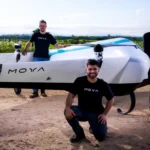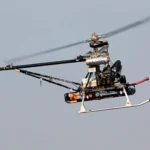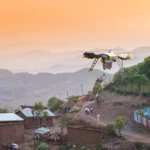Advanced Air Mobility
AAM, also referred to as urban air mobility (UAM), is a new concept in air transportation that uses autonomous aircraft to transport people and cargo. These aircraft, primarily eVTOLs, can be powered by hybrid electric systems, batteries or, potentially, hydrogen fuel cells.
These aircraft, which will range in size from small drones to large shuttles to single and multi-passenger eVTOL vehicles, will bring accessibility to cities, underserved communities and geographically distant regions.
The development of infrastructure to support Advance Air Mobility is already underway in cities, and AAM is expected to become an increasingly important part of our transportation system in the coming years. Advanced Air Mobility (AAM) is an air transportation system concept that integrates new aircraft designs and transformational flight technologies into existing and modified airspace operations.
Its goal is to move people and cargo between locations more efficiently, especially. The Federal Aviation Administration (FAA) will regulate development and operations, and will monitor and address safety and security issues that may arise, as these designs come to market.
Types of advanced air mobility vehicles under development
The AAM concept creates innovative and cost-effective aircraft with a low carbon footprint. Virtually all AAM vehicles developed have all-electric or hybrid-electric power systems. Many are highly automated to navigate from point to point safely without a human operator on board.
Most designs fall into one or more of these types:
- Electric vertical takeoff and landing (eVTOL) designs focus on the areas of on-demand air cabs, airport passenger transfers, patient transfers, rooftop-to-city travel, etc. Some eVTOLs have on-board or remote pilots; others have automated “self-steering” navigation.
- Electric conventional take-off and landing (eCTOL) aircraft are used for short-range travel, small cargo deliveries, and passenger transfers from regional and rural airstrips.
- Small unmanned aerial systems (sUAS), also popularly known as drones or unmanned aerial vehicles (UAVs), for videography, delivery and pickup of small packages, transfer of medical supplies, etc.

Autonomous controls and detection sensors
In addition to electric motors and advanced aircraft power systems, aviation and aerospace companies developing AAM / UAM solutions for unmanned aircraft need autonomous flight control systems. These can range from level 1 or 2 autonomy, where the aircraft still needs human control but has pilot support systems, to a fully autonomous level 5 aircraft.
This level of autonomy will require the developer to include electronic data sensors-from cameras and scanners to inertial navigation systems (INS), GNSS receivers and others-as well as signal processing to convert the information into “smart” navigation decisions, compensate for system errors and avoid collisions.
Advanced Air Mobility or Urban Air Mobility?
Urban Air Mobility (UAM) is leading the way in Advanced Air Mobility, focusing on sustainable air mobility technologies for urban environments. Why? Firstly, because all the advances developed for UAM can also be used to solve problems in rural and regional areas.
Equally important, however, is that the use case studies demonstrate that businesses and individuals will use UAM vehicles and services much more often and sooner, which will demonstrate their cost-effectiveness and make them financially viable more quickly. As that financial strength grows, it can also help support the growth of the less urban elements of AAM operations.
At Embention we are working to make this a reality.
An example of this is our Veronte autopilot redundant 4x. It is the first autopilot for eVTOL that includes 4x redundancy, being compatible with all types of vehicles and aircraft and complies with all aviation standards DO178C / ED-12 and DO254 allowing the certification of UAV, RPAS and UAM. In addition, it has environmental tests according to DO160 / MIL-STD-810, MTBCF data and manufacturing reports




